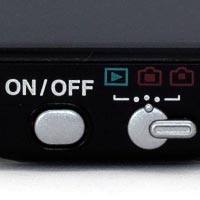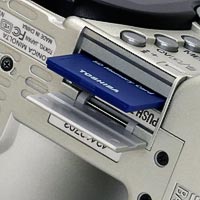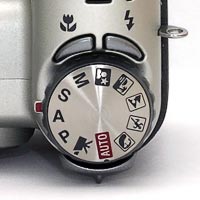Konica Minolta DiMAGE Z5
Review Date: April 25th 2005
|
Ease of Use
The Konica Minolta DiMAGE Z5 instantly reminded me of the Fuji FinePix S7000, S5000 and S20 Pro cameras that I have previously reviewed, with a large lens barrel and handgrip that dominate the overall design of the camera. Konica Minolta have given the Z5 a much more modern, almost futuristic look than those cameras, with a shiny silver body and sloping lens barrel that houses the extending zoom lens. The body is entirely made out of a plastic that doesn't feel like the most durable in the world, although the weight of the camera does counteract this to some extent. The handgrip has quite a lot of flex, more so than the cheaper Konica Minolta DiMAGE Z20 that I reviewed last week. This is because the handgrip is connected to the rest of the camera by a thinner bridge than on the Z20. A grippier kind of dark-grey plastic has been added to both the right and left sides of the body where you would naturally hold it, ensuring that you can get a good grip on what is quite a large camera in terms of both dimensions and weight.
On the rear of the camera is the generously sized 2 inch LCD screen and an electronic viewfinder with dioptre control. The large LCD screen is a welcome improvement on the small 1.5 inch screen found on the Konica Minolta DiMAGE Z20. Konica Minolta have come up with a novel solution to switching between the LCD screen and the EVF. Instead of having both powered on at the same time and therefore wasting vital battery life, the camera only allows you to select one or the other by using the Mode switch on the rear. If you select the LCD option, the EVF automatically turns off, and if you choose the EVF option, the LCD turns off. If you select the third option, Play, the LCD screen is used for displaying the images that you have taken. This system takes a bit of getting used to at first - on older Konica Minolta cameras like the DiMAGE 5 and DiMAGE 7 series, the switch between the LCD screen and EVF was activated by eye control, but obviously Konica Minolta have decided that this is too complex and expensive to implement on their current range of cameras. Having said that, the Mode switch system works well enough and after a while it will become second nature to switch from, say, EVF to LCD and back again.
On the top of the camera sits the exposure mode dial, which is the equivalent to the control centre in terms of how simple or complicated you want the camera to be. If you're a beginner, choose the full Auto or Program mode, or one of the various Scene modes, and let the camera take control of setting apertures and shutter speeds whilst you concentrate on capturing the moment. If you want more control, use the A, S or the M modes so that you can tell the camera exactly what to do. Konica Minolta have used an industry standard icon system that will be instantly recognisable to anyone who has used a 35mm SLR camera before.
| Flash | On/Off Button / Mode Switch |
 |
 |
Next to the exposure mode dial are the Macro and Flash buttons, Nothing too exciting there, you might think, except that the Flash button can optionally be configured to select other key configuration options, such as white balance and ISO speed. Simply choose the Key func. option from the menu and then select what you want this button to control - a great way of making a particular feature that you alter a lot easily accessible and quick to operate.
The built-in flash may initially confuse you, as there is no button to automatically pop it up. Instead you have to grip the raised edges on either side of the flash and raise it into position, then push it back down to close it. Note that you cannot select any of the flash options on the camera's menu unless the flash unit is raised. On top of the flash unit is a hotshoe for an optional external flashgun, very handy if the built-in flash isn't powerful enough for you.
The Konica Minolta DiMAGE Z5 is very well-made, despite its all-plastic construction, with nothing that feels as though it will fall off given enough wear and tear. Konica Minolta have dispensed with the unprotected memory card slot on the cheaper Z20 and Z10 cameras, instead positioning the slot on the bottom of the camera with its own protective cover. Apart from the flexy handgrip, the Konica Minolta DiMAGE Z5 has a reassuringly expensive feel to it.
Konica Minolta have done an excellent job in designing a camera that doesn't have too many external buttons and switches, especially considering the complexity and functionality of the camera. There are 12 external controls in total, with most of them clearly labeled and understandable. I was initially confused by the i+ button, which actually simply toggles between different screen display options. The shutter button is large and tactile, as are the zoom switch and the other controls on the rear of the camera. The only small niggles that I had from a handling point of view were the positioning of the shutter button, which sits in a recess ( I would prefer it to be slightly raised), and the zoom switch, which uses a sliding system. You push it left to zoom out and push it right to zoom out, which is different to the push down system that most digital cameras use. Otherwise the Konica Minolta Z5 was a joy to use, quickly becoming second-nature.
The menu system of the Konica Minolta DiMAGE Z5 is as well designed as the exterior of the camera. It uses an intuitive tabbed interface with 3 numbered pages and a Setup option at the top of the screen. There are only ever a maximum of 5 options per page, which are all shown onscreen at the same time, so no scrolling through an endless list trying to find that elusive option. The large 2 inch LCD screen also helps by allowing a large, clear typeface to be used.
| Memory Card Slot | Macro Button / Flash Button / Exposure Dial |
 |
 |
One of the main selling points of the Konica Minolta DiMAGE Z5 is its unique CCD-shift anti-shake mechanism, which is also implemented on the much more expensive Konica Minolta 7D DSLR camera. This allows you to take sharp photos at slower shutter speeds than other digital cameras, and it works really well - you can see the results for yourself on the next page. From an ease of use point of view, enabling this feature is done via the menu system - it would be nice if there was a dedicated external button, as on the Konica Minolta DiMAGE A200. You don't notice that the camera is actually doing anything different when anti-shake is turned on, just that you can use slower shutter speeds than normal and still take sharp photos.
So what is the Konica Minolta DiMAGE Z5 like to actually operate and take a photo? The start-up time from turning the camera on to being ready to take a photo is fairly quick, taking around 1.5 seconds. Zooming the lens from the widest focal length to the longest is a bit slower at around 2 seconds, understandable given that it covers a range of 35mm to 420mm. Focusing is very quick and responsive in good light and also indoors and in low-light situations, although performance dropped off indoors at the telephoto end of the zoom. Both the refresh rate and visibility of the LCD screen are very good and it is visible even in bright sunlight. The EVF, typically a weak point of digital cameras in the past, is large, bright and consequently very useable. Images are stored quickly with the camera ready to take another image almost instantly. Continuous mode is is pretty rapid, allowing you to take up to 5 photos in less than a second (at any image quality and size combination). The camera does lock up for about 1 second, however, after a sequence of shots in continuous mode. There is also an Ultra High Speed mode, but this only allows for 1024x768 pixel images to be taken. There is also a continuous autofocus mode for tracking moving subjects which works well.
Once you have captured a photo, the Konica Minolta DiMAGE Z5 has a lot of options when it comes to playing, reviewing and managing your images. You can scroll through the images that you have taken, zoom in and out to a factor of x6 and play a slideshow. You can rotate images, choose which images to Lock (to prevent them from being deleted), and delete an image. You can configure which images you want to print, selecting whether to print the date, how many copies you want to print and if you want to make an index print. Making a copy of an image that you have taken is also possible, and you can select images that will be attached to an email when you download onto your computer. Importantly there is a histogram to show the exposure of a recorded image, and you can also choose to display one whilst you are taking a photo.
I thoroughly enjoyed reviewing the Konica Minolta DiMAGE Z5. It's a very well-designed camera that offers all of the functionality that will allow your photography to flourish, giving you full control over the photographic process. Full manual, aperture-priority and shutter-priority exposure modes are very welcome, and the Z5 offers the best of both worlds, being perfectly at home as a point and shoot camera in the various auto or scene modes, or allowing you to take more control if you wish. And let's not forget that massive 12x optical zoom lens, which makes the Konica Minolta DiMAGE Z5 suitable for all situations.
|
 PhotographyBLOG is a member of the DIWA organisation. Our test results for the Konica Minolta DiMAGE Z5 have been submitted to DIWA for comparison with test results for different samples of the same camera model supplied by other DIWA member sites.
PhotographyBLOG is a member of the DIWA organisation. Our test results for the Konica Minolta DiMAGE Z5 have been submitted to DIWA for comparison with test results for different samples of the same camera model supplied by other DIWA member sites.
